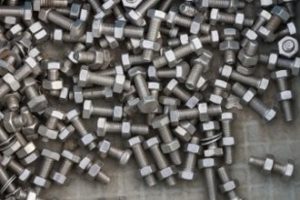 Regardless of how careful you are when you install nuts and bolts, it’s bound to happen: stripped threads. When tightened, bolts create a radial spreading force, and this often leads to cracked, damaged, and stripped bolt holes. Bolts can also be damaged from incorrect fastener size, wrong thread pitch, cross-threading, thread galling, rusting, excessive pull-out force, thread fretting, or even just repeated use. Aluminum is especially notorious for damaged threads, but in reality, all threaded fasteners can strip or experience damage rendering them unusable. All hope isn’t lost though. You can fix the problem by repairing the damaged threads.
Regardless of how careful you are when you install nuts and bolts, it’s bound to happen: stripped threads. When tightened, bolts create a radial spreading force, and this often leads to cracked, damaged, and stripped bolt holes. Bolts can also be damaged from incorrect fastener size, wrong thread pitch, cross-threading, thread galling, rusting, excessive pull-out force, thread fretting, or even just repeated use. Aluminum is especially notorious for damaged threads, but in reality, all threaded fasteners can strip or experience damage rendering them unusable. All hope isn’t lost though. You can fix the problem by repairing the damaged threads.
High Volume Thread Repair
Depending on your end use, you may be in a situation where you deal with large quantities of fasteners. These fasteners can become damaged through rough handling, container damage, or even by the threads hitting against each other.
In these cases, it is not efficient to repair each bolt individually by hand. Subject to various factors including the type of damage, the plating involved, and the size of the part. It is possible to repair the damage in a cost effective way by hiring a company who maintains the necessary thread repair equipment and can handle large volumes.
While not practical for the average person in their garage, this option is a good one for those who have invested thousands of dollars in a large volume of fasteners.
Reshaping Threads
Instead of cutting new threads on your bolts, you can reshape them to their original condition after removal. This is ideal when your fasteners are only partially stripped. First, you’ll need to find the bolt’s pitch (metric) or thread count (SAE). You can do this with a thread file or thread gauge—hold it against the threads until you find the right match.
Place your bolt in a vise, engage the thread file grooves and then push on it. This will reset your threads enough to be able to screw on a rethreading die. Put some oil on your bolt and then use the rethreading die to restore it to its original condition. A tap is used for female threads and a die is used to create male threads. The process will take a few operations: don’t do it all at once and avoid cross threading. Rotate the rethreading die or tap few times, and then back it up a full turn in order to dislodge debris. Repeat the process until you see solid threads.
Oversize Thread Replacement
One of the simplest and fastest thread repair methods is to drill out only the stripped threads and tap the hole to the next size up. However, using different thread sizes in a bolt hole pattern isn’t ideal—you’ll then need non-standard fasteners and torque specifications. Instead, you could over-size all of the threads, even if you only have one that is stripped, though this takes more time and effort and could weaken your machine or device.
You can also weld-up the existing hole and then drill a new hole. Then, cut new threads with a tap.
Thread Repair Inserts
You also have the option of using inserts to fix your stripped or damaged bolt holes. These inserts provide strength and durability. You use a specific drill size and tap to put oversize threads into the hole. Then tighten the insert into the threaded hole, some inserts rely on special sealing compounds such as loctite to hold it in place and keep it from turning while others are tightened against the bottom of a blind hole. When you use a thread repair kit with inserts, the kit will specify which correct-sized bit to use and will also supply the tap, so you don’t have to guess and risk damaging the insert, fastener, or assembly further.
Which Thread Repair Method to Use?
The method you should use is going to be based on several factors, including the number of fasteners you need repaired, the material type, the design of your work piece, the type of thread damage to be repaired, the pull-out strength required, and the physical access you have to accomplish the repair. It is important to keep in mind that some damage is not repairable given the use the item will be put to. In these cases, the damaged item should be thrown out and replaced.
Fix It and Forget It
Although repairing threads isn’t as difficult as it seems, you don’t have to try taking on the task by yourself. If you don’t know what you’re doing, you risk damaging your parts further. Instead, you can take your stripped bolts to a thread repair professional or repair shop that specialize in repairing the assembly the damage is in who can do the job for you. Your fasteners will come back good as new. When you have stripped, damaged bolts, or threaded holes there’s no reason to waste your money buying new bolts or new components. Just fix them and forget it.
White Paper: JS Plus™ Plating
Discover a New Superior Plating Option
